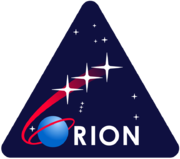Artemis 1
| Operator | NASA/ESA |
|---|---|
| COSPAR ID | 2022-156A |
| SATCAT no. | 54257 |
| Spacecraft properties | |
| Spacecraft type | Orion MPCV |
| Start of mission | |
| Launch date | November 2018[1] |
| Rocket | SLS Block 1[2] |
| Launch site | Kennedy LC-39B[3] |
| End of mission | |
| Landing site | Pacific Ocean[4] |
| Orbital parameters | |
| Reference system | Geocentric |
| Regime | Circumlunar |
| Flyby of the Moon | |
| Closest approach | December 2018 |
| Distance | TBD |

Beyond Low Earth Orbit Program | |
Exploration Mission 1 or EM-1 (previously known as Space Launch System 1 or SLS-1) is the first planned flight of the Space Launch System and the second uncrewed test flight of the Orion Multi-Purpose Crew Vehicle. As of December 2014[update], the launch is projected to occur September 30, 2018 from Launch Complex 39B at the Kennedy Space Center, and the Orion spacecraft would perform a circumlunar trajectory during the seven day mission.[3][5] It is planned to be followed by Exploration Mission 2.
Overview
The Block 1 version of SLS used on this mission will consist of two five-segment Solid Rocket Boosters, four RS-25D engines built for the Space Shuttle program and an Interim Cryogenic Propulsion Stage.[5] EM-1 is intended to demonstrate the integrated spacecraft systems prior to a crewed flight and demonstrate a high speed reentry (11 km/s) on Orion's thermal protection system.[5]
On January 16, 2013, NASA announced that the European Space Agency would build Orion's service module based on its Automated Transfer Vehicle, so the flight could also be regarded as a test of ESA hardware as well as American, and of how the ESA components interact with the American Orion components.[6]
The EFT-1 flight article was consciously constructed in a way that if all the missing components (seats, life support systems) were added, it would not meet the mass target. It was planned that subsequent capsules would be modified to be lighter, based on manufacturing experience.
In January 2015 NASA and Lockheed announced that the EM-1 capsule would be 25 percent lighter compared to the previous one. This would be achieved by changes to the primary structure - the EM-1 article it would be welded together from three panels for the cone, as opposed to 6 panels used for the EFT-1 article. The total number of welds was reduced from 19 to 7 [7], thus saving the additional mass of the weld material. Other savings would be thanks to revisiting its various components and wiring. For EM-1 the capsule will be outfitted with complete life support system and crew seats, just no crew.[8]
Gallery
-
Artist's rendering of the launch of EM-1
-
EM-1's orbital path
Predecessors
Apollo 8 had a similar flight path and was also a mission designed to flight test a Command Service Module beyond Earth orbit; it was crewed by 3 astronauts and was lifted by the Saturn V vehicle in 1968.
Apollo 13 also flew a similar flight path after sustaining damage in an explosion. The spacecraft remained on a free return trajectory as it passed the moon, and as a result it holds the current absolute altitude record for a manned spacecraft. The mission's commander, Jim Lovell, holds the distinction of having set this record twice, the first time on Apollo 8.
References
- ^ Exploration Mission 1: SLS and Orion mission to the Moon outlined, Chris Bergin, 29 February 2012
- ^ Bergin, Chris (23 February 2012). "Acronyms to Ascent – SLS managers create development milestone roadmap". NASASpaceflight.com. Retrieved 14 July 2012.
- ^ a b Hill, Bill (March 2012). "Exploration Systems Development Status" (PDF). NASA Advisory Council. Retrieved 21 July 2012.
- ^ Bergin, Chris (14 June 2012). "NASA teams evaluating ISS-built Exploration Platform roadmap". NASASpaceflight.com. Retrieved 21 July 2012.
- ^ a b c Singer, Jody (25 April 2012). "Status of NASA's Space Launch System" (PDF). NASA Marshall Space Flight Center. Retrieved 5 August 2012.
- ^ "Engineers resolve Orion will 'lose weight' in 2015". NASA. 2013-01-16. Retrieved 2013-03-22.
- ^ "Orion program manager talks EFT-1 in Huntsville". http://www.waaytv.com. 13 January 2015. Retrieved 15 January 2015.
{{cite web}}: External link in|publisher= - ^ "Acronyms to Ascent – SLS managers create development milestone roadmap". www.waff.com. 13 January 2015. Retrieved 15 January 2015.
External links



